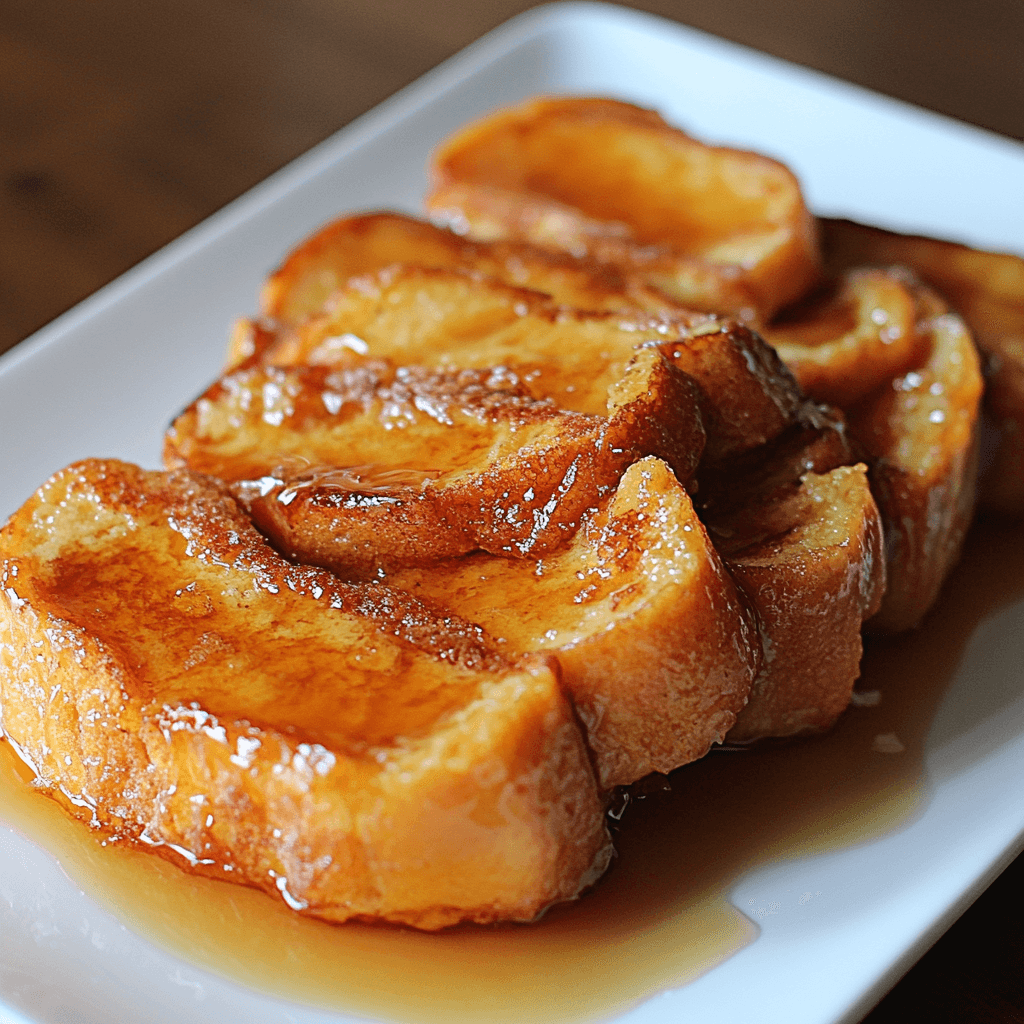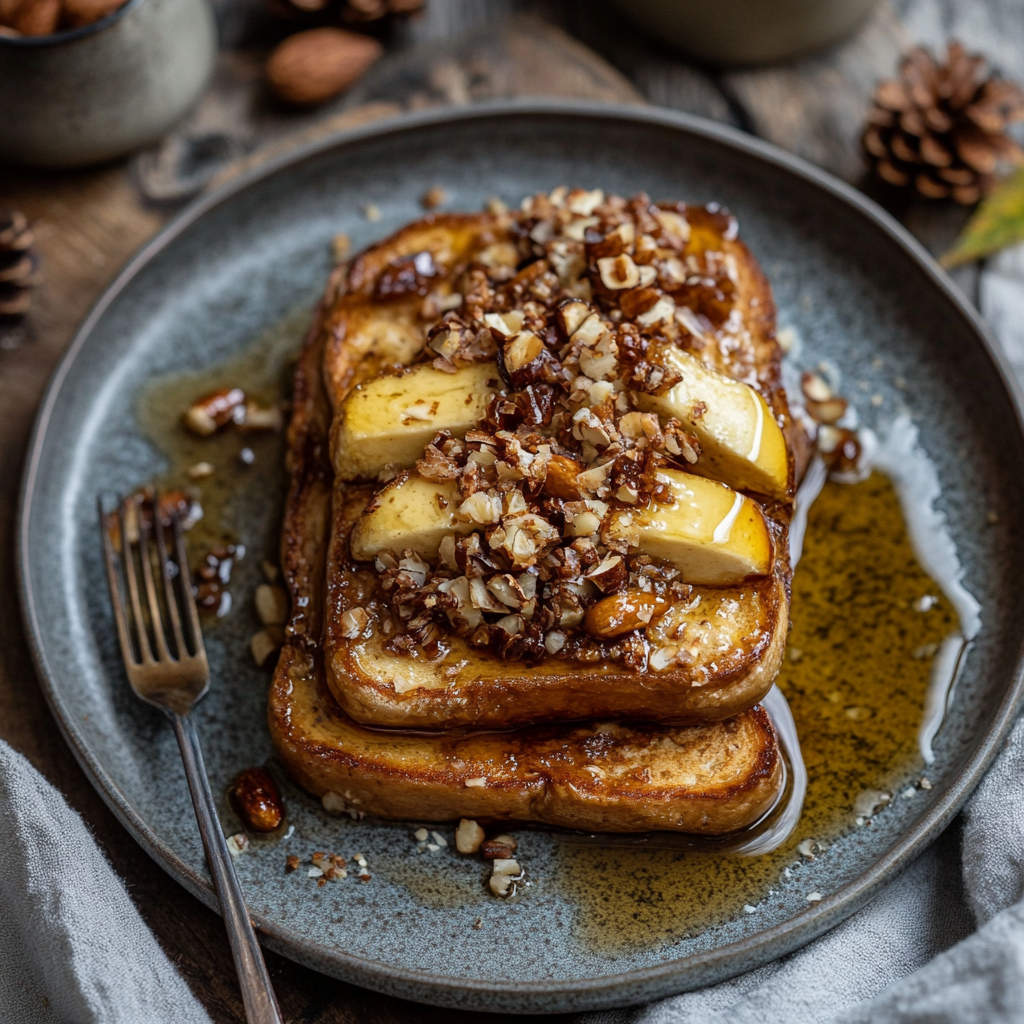Introduction tThe Ultimate French Toast Recipe Brioche for a Perfect Breakfast
Introduction to French Toast Made with Brioche
What Makes Brioche the Best Choice for French Toast?
Brioche is the ultimate bread for French toast due to its rich, buttery texture and slight sweetness. Unlike regular sandwich bread, brioche has a tender crumb that absorbs the egg custard without falling apart. When cooked, it develops a beautifully golden, crisp exterior while staying soft and custardy on the inside. This combination makes brioche French toast an indulgent and elegant breakfast option perfect for any occasion.
The Origins and Popularity of French Toast
French toast, or “pain perdu” (meaning “lost bread”), originated as a way to repurpose stale bread by soaking it in a mixture of milk and eggs and frying it to perfection. Over time, this humble dish spread across the globe, evolving into a beloved breakfast staple. From the classic version in France to variations like stuffed French toast and French toast sticks, it remains a versatile favorite. Brioche French toast stands out as a modern take on this classic, offering a more luxurious and decadent experience.
Why This Recipe Stands Out
This brioche French toast recipe stands out for its simplicity and indulgence. By using high-quality brioche bread, a perfectly balanced custard infused with cinnamon and vanilla, and tips for achieving the ideal golden-brown finish, this recipe delivers restaurant-quality results at home. Whether you’re making breakfast for a lazy Sunday morning or a special brunch, this dish is guaranteed to impress your family and guests.
Ingredients for French Toast Recipe Brioche
Essential Ingredients You’ll Need for This Recipe
To make the perfect brioche French toast, gather these key ingredients:
- Brioche Bread: Thick slices of day-old brioche for the best texture.
- Eggs: The foundation of the custard mixture, providing richness and structure.
- Milk or Heavy Cream: Adds creaminess to the custard—whole milk or half-and-half works best.
- Vanilla Extract: Enhances the sweetness and adds a warm, aromatic flavor.
- Ground Cinnamon: Adds a cozy, spiced note that pairs perfectly with brioche.
- Sugar: A touch of sugar sweetens the custard without overpowering it.
- Butter: For frying, ensuring a rich flavor and golden-brown crust.
- A Pinch of Salt: Balances the sweetness and brings out the custard’s flavors.
Substitutes for Key Ingredients (Milk, Eggs, Sugar)
If you need to adjust for dietary preferences or allergies, here are some alternatives:
- Milk: Use almond milk, oat milk, or coconut milk for a dairy-free option.
- Eggs: Substitute with a flax egg (1 tablespoon ground flaxseed mixed with 3 tablespoons water per egg) or a cornstarch slurry.
- Sugar: Replace refined sugar with natural sweeteners like honey, maple syrup, or coconut sugar for a healthier alternative.
These substitutions ensure you can customize the recipe while maintaining its delicious flavor and texture.
Selecting the Best Brioche Bread
Choosing the right bread is essential for achieving perfect French toast:
- Fresh or Day-Old Brioche: Slightly stale bread absorbs the custard better without becoming soggy. If your brioche is fresh, lightly toast it in the oven for a few minutes.
- Thick-Cut Slices: Opt for slices that are about 1 inch thick to ensure they hold up during soaking and frying.
- Quality Matters: Look for artisanal brioche or bakery-fresh loaves with a rich, buttery flavor and soft, fluffy texture.
By using the best ingredients and thoughtful substitutions, this recipe guarantees a French toast experience that’s rich, flavorful, and indulgent—perfect for any breakfast table!
Kitchen Tools You’ll Need
Must-Have Equipment for Perfect French Toast
To make perfect brioche French toast, gather these essential kitchen tools:
- Mixing Bowl: A medium-sized bowl for whisking the egg custard mixture.
- Whisk: For combining the eggs, milk, cinnamon, and vanilla smoothly.
- Non-Stick Skillet or Griddle: A non-stick surface ensures even cooking without sticking, helping achieve that golden-brown crust.
- Spatula: A wide, flat spatula makes flipping the French toast easy without tearing the bread.
- Measuring Cups and Spoons: For precise measurements of milk, sugar, and spices.
Optional Tools to Simplify the Cooking Process
- Bread Knife: For slicing thick, even pieces of brioche bread if it’s not pre-sliced.
- Cooking Brush: To evenly apply melted butter to the skillet for consistent browning.
- Baking Sheet and Oven: If cooking for a crowd, you can keep cooked French toast warm in a 200°F (95°C) oven while finishing the rest.
- Electric Griddle: An electric griddle allows you to cook multiple slices simultaneously, perfect for brunch gatherings.
Step-by-Step Instructions for French Toast Recipe Brioche
Preparing the Egg Custard Mixture
- In a medium-sized mixing bowl, whisk together the following ingredients:
- 3 large eggs
- ¾ cup whole milk or heavy cream
- 1 teaspoon vanilla extract
- 1 teaspoon ground cinnamon
- 1 tablespoon sugar
- A pinch of salt to enhance the flavors.
- Whisk until the mixture is smooth, and the cinnamon is evenly distributed without clumps.
How to Slice and Prepare the Brioche Bread
- Use a bread knife to slice the brioche loaf into thick slices, about 1 inch thick. Thick slices absorb the custard without falling apart.
- If the brioche is fresh, place the slices on a baking sheet and let them sit uncovered for about 30 minutes to dry slightly. Alternatively, lightly toast them in a 300°F (150°C) oven for 5–7 minutes.
Dipping and Coating the Bread Perfectly
- Heat a non-stick skillet or griddle over medium heat and melt 1 tablespoon of butter.
- Quickly dip each slice of brioche into the custard mixture. Let the bread soak for about 5–10 seconds per side—just enough to coat the surface without saturating it.
- Allow any excess custard to drip off the bread before transferring it to the skillet.
Cooking the Brioche French Toast on the Stovetop
- Place the custard-coated brioche slices onto the heated skillet. Avoid overcrowding to ensure even cooking.
- Cook each slice for about 2–3 minutes per side, or until golden brown and crispy on the outside. Adjust the heat if needed to prevent burning.
- Flip carefully using a spatula and cook the other side to perfection. Add a little more butter to the skillet if necessary for subsequent batches.
- Transfer the cooked French toast to a plate or a baking sheet in a warm oven (200°F) to keep it hot while you finish cooking the rest.
Serve immediately with your favorite toppings, such as maple syrup, powdered sugar, or fresh fruit, for a rich and satisfying breakfast experience!
Tips to Make the Perfect Brioche French Toast
How to Avoid Soggy or Overly Dry French Toast
The key to achieving the perfect texture lies in balance:
- Don’t Oversoak: Dip the brioche slices for 5–10 seconds per side, just enough to absorb the custard without becoming saturated. Oversoaking leads to soggy results.
- Use the Right Bread: Slightly stale brioche works best, as it absorbs the custard while holding its shape.
- Drain Excess Custard: Allow any extra custard to drip off before cooking to prevent mushy toast.
Managing Cooking Temperature for a Golden-Brown Finish
Proper temperature control ensures a crispy, golden exterior and a soft, custardy interior:
- Cook the brioche on medium heat to allow the custard to cook through evenly without burning the surface.
- Use butter for frying, as it adds flavor and helps achieve a golden-brown finish. If the butter browns too quickly, lower the heat slightly.
- Avoid rushing—patience ensures consistent results.
Using Fresh vs. Stale Brioche Bread
- Stale Brioche: Slightly dry, day-old brioche is ideal for French toast because it soaks up the custard without falling apart.
- Fresh Brioche: If using fresh bread, lightly toast it in the oven at 300°F (150°C) for about 5–7 minutes to remove excess moisture. This helps prevent sogginess.
Creative Variations of French Toast Recipe Brioche
Classic Cinnamon Brioche French Toast
For a timeless version, add extra cinnamon for warmth and depth:
- Mix 1 teaspoon of cinnamon and a pinch of nutmeg into the custard mixture.
- Top with powdered sugar, a drizzle of maple syrup, and a sprinkle of cinnamon for added flavor.
Stuffed Brioche French Toast with Cream Cheese and Berries
Turn your French toast into a decadent stuffed delight:
- Spread softened cream cheese on one slice of brioche and top with fresh berries like strawberries, raspberries, or blueberries.
- Place another slice of brioche on top to form a sandwich.
- Dip in the custard mixture and cook as usual.
- Serve with a dusting of powdered sugar and berry compote for a luxurious breakfast treat.
Chocolate Chip Brioche French Toast
For a kid-friendly and indulgent variation:
- Add a handful of chocolate chips to the custard-soaked brioche slices before cooking.
- As the toast cooks, the chocolate chips will melt slightly, creating gooey pockets of sweetness.
- Serve with whipped cream and a drizzle of chocolate sauce for extra decadence.
Savory Brioche French Toast with Cheese and Herbs
For a unique twist, skip the sugar and cinnamon to create a savory version:
- Prepare the custard with eggs, milk, salt, black pepper, and finely chopped herbs like parsley, thyme, or chives.
- Dip the brioche slices and cook as usual.
- Before serving, sprinkle with grated cheese like cheddar, gruyère, or parmesan, and let it melt slightly.
- Pair with crispy bacon or sautéed mushrooms for a hearty, savory breakfast.
These creative variations ensure your brioche French toast is versatile, indulgent, and suited for any taste preference—whether sweet, stuffed, or savory!
Toppings to Elevate Brioche French Toast
Classic Toppings: Maple Syrup, Butter, and Powdered Sugar
The classics never go out of style and perfectly complement the rich, buttery flavor of brioche French toast:
- Maple Syrup: A warm drizzle of pure maple syrup adds natural sweetness and enhances the toast’s flavor.
- Butter: A small pat of butter melts into the warm toast, adding richness and depth.
- Powdered Sugar: A light dusting of powdered sugar gives an elegant touch and a hint of extra sweetness.
Fruit-Based Toppings: Strawberries, Bananas, and Blueberries
Adding fresh fruit balances the indulgence of brioche French toast with natural sweetness and a burst of color:
- Strawberries: Freshly sliced strawberries offer a bright, slightly tangy contrast.
- Bananas: Sliced bananas, either fresh or caramelized, add a creamy, sweet texture.
- Blueberries: A handful of fresh or lightly sautéed blueberries provides a juicy and antioxidant-rich topping.
For an extra boost, pair these fruits with a light drizzle of honey or a sprinkle of cinnamon.
Indulgent Options: Whipped Cream, Caramel, or Chocolate Sauce
For a decadent breakfast or brunch treat, try these indulgent toppings:
- Whipped Cream: A dollop of lightly sweetened whipped cream adds an airy, creamy finish.
- Caramel Sauce: Drizzle warm caramel sauce over the French toast for a buttery, sweet flavor that pairs perfectly with brioche.
- Chocolate Sauce: Melted dark, milk, or white chocolate creates a luxurious and irresistible topping. Add chocolate shavings for a sophisticated touch.
- Nutella or Peanut Butter: Spread a thin layer for a rich, nutty twist, topped with sliced bananas or strawberries.

Pairing Suggestions for a Complete Breakfast
Perfect Beverage Pairings: Coffee, Tea, and Fresh Juice
The right beverage completes your brioche French toast breakfast:
- Coffee: A strong cup of black coffee, a creamy latte, or a cappuccino perfectly balances the sweetness of the French toast. Sprinkle a dash of cinnamon for a complementary flavor.
- Tea: Choose warming teas like chai, Earl Grey, or green tea for a lighter, refreshing pairing.
- Fresh Juice: Freshly squeezed orange juice, apple juice, or a berry smoothie adds brightness and a fruity note to your meal.
Sides That Complement French Toast: Eggs, Bacon, or Sausages
Make your brioche French toast a complete breakfast by pairing it with savory sides:
- Scrambled or Fried Eggs: Soft, fluffy eggs add protein and balance the sweetness of the toast.
- Bacon: Crispy, smoky bacon provides a salty contrast to the buttery, sweet brioche.
- Sausages: Breakfast sausages, whether classic or spiced, add a hearty, savory element to the meal.
- Roasted Potatoes: Serve golden, herbed breakfast potatoes for a satisfying and filling side.
These pairings create a well-rounded, restaurant-quality breakfast that’s indulgent, balanced, and sure to impress any crowd. Whether you opt for classic toppings or a full breakfast spread, brioche French toast is the perfect centerpiece for a memorable morning meal.
Nutritional Information for French Toast Recipe Brioche
Macronutrient Breakdown (Calories, Carbs, Protein, Fat)
The nutritional content for a standard serving of brioche French toast (1 slice of brioche with basic toppings like syrup and butter) is approximately:
- Calories: 250–350 kcal
- Carbohydrates: 30–35g (from bread and added sugar)
- Protein: 8–10g (from eggs and milk)
- Fat: 10–15g (from eggs, milk, and butter used for cooking)
The exact values will vary depending on the bread thickness, cooking method, and toppings. Adding indulgent options like whipped cream or chocolate will increase the calorie and fat content, while fruits and natural sweeteners can keep the meal lighter.
How to Adjust the Recipe for Healthier Options
To make brioche French toast a healthier option without compromising taste:
- Use Whole-Grain Brioche: Swap classic brioche for whole-grain or sprouted grain bread for added fiber and nutrients.
- Reduce Sugar: Skip sugar in the custard mixture and rely on natural sweetness from vanilla and cinnamon. Use fresh fruit or a drizzle of honey instead of syrup.
- Dairy-Free Alternatives: Replace whole milk with almond milk, oat milk, or coconut milk for a lower-calorie, lactose-free option.
- Cook with Less Butter: Use a light spray of non-stick cooking oil or a small amount of coconut oil instead of butter for frying.
By making these small adjustments, you can enjoy a lighter version of this classic indulgence.
Storage and Reheating Tips for Leftover Brioche French Toast
How to Store French Toast Properly
- Allow the cooked brioche French toast to cool completely to avoid condensation.
- Place the slices in a single layer on a plate or baking sheet and cover with plastic wrap or transfer them to an airtight container.
- Store in the refrigerator for up to 3–4 days. If stacking the slices, separate them with parchment paper to prevent sticking.
Reheating Techniques: Skillet, Oven, and Microwave
Reheat your French toast using one of these methods for the best results:
- Skillet (Best for Crispiness):
- Heat a non-stick skillet over medium heat.
- Add a small amount of butter or oil and warm each slice for 1–2 minutes per side until crispy and heated through.
- Oven (Great for Large Batches):
- Preheat the oven to 350°F (175°C).
- Arrange the slices in a single layer on a baking sheet and cover loosely with foil.
- Bake for 8–10 minutes, flipping halfway through for even heating.
- Microwave (Quickest Option):
- Place a slice on a microwave-safe plate.
- Heat in 30-second intervals until warm. Note: The texture may be softer compared to other methods.
Freezing French Toast for Future Meals
French toast freezes well, making it a perfect option for meal prep:
- Allow the French toast to cool completely.
- Place the slices in a single layer on a baking sheet and freeze for 1–2 hours until firm.
- Transfer the frozen slices to a freezer-safe bag or airtight container, separating layers with parchment paper. Label with the date.
- Freeze for up to 2 months.
Reheating from Frozen:
- Oven: Bake frozen slices at 350°F (175°C) for 10–12 minutes, flipping halfway through.
- Toaster: Place frozen slices in the toaster on a medium setting until crispy and warmed through.
- Air Fryer: Heat at 350°F for 5–6 minutes, flipping halfway for even cooking.
With these storage and reheating tips, you can enjoy fresh, perfectly cooked brioche French toast anytime—whether it’s for a quick weekday breakfast or a leisurely weekend brunch.
Frequently Made Mistakes When Making French Toast with Brioche
Oversoaking the Bread
One of the most common mistakes when making brioche French toast is oversoaking the bread. Brioche is soft and absorbent, so leaving it in the custard mixture for too long can cause it to fall apart or become soggy.
- Tip: Dip each slice of bread into the custard for 5–10 seconds per side, just enough to coat it evenly. Allow excess custard to drip off before cooking.
Using the Wrong Heat Setting
Cooking French toast at the wrong temperature can ruin the texture:
- High Heat: The outside will burn quickly while the inside remains raw.
- Low Heat: The toast will cook too slowly and may turn soggy or greasy.
- Solution: Use medium heat for a golden-brown exterior and a fully cooked, custardy interior. Adjust the heat if necessary, and add butter gradually to prevent burning.
Choosing the Wrong Bread Texture
Brioche works perfectly for French toast, but using the wrong type or texture of bread can lead to poor results:
- Too Fresh: Fresh brioche may become too soft when soaked, resulting in a mushy texture.
- Too Thin: Thin slices won’t hold up to the custard and may fall apart during cooking.
- Solution: Use slightly stale or day-old brioche and slice it about 1 inch thick to ensure the bread stays sturdy and absorbs the custard evenly.
Vegan and Dairy-Free Alternatives for Brioche French Toast
Vegan Brioche Bread Options
Traditional brioche contains eggs and butter, but vegan alternatives are widely available:
- Look for vegan brioche loaves at specialty bakeries or stores. These are made with plant-based butter and milk alternatives.
- If you’re baking your own vegan brioche, replace eggs and butter with ingredients like coconut oil, vegan butter, or applesauce for moisture.
Substituting Milk, Eggs, and Butter with Plant-Based Ingredients
You can easily adapt brioche French toast to be vegan and dairy-free by using these substitutions:
- Milk: Replace dairy milk with plant-based options such as:
- Almond milk: Light and nutty.
- Oat milk: Creamy and naturally sweet.
- Coconut milk: Adds richness and a subtle tropical flavor.
- Eggs: Replace eggs in the custard with one of the following alternatives:
- Flaxseed Egg: Mix 1 tablespoon of ground flaxseed with 3 tablespoons of water for each egg. Let it sit for 5 minutes to thicken.
- Cornstarch Mixture: Combine 1 tablespoon of cornstarch with 3 tablespoons of plant milk for binding.
- Banana Puree: Use ½ a ripe banana, mashed, for a naturally sweet and creamy alternative.
- Butter: Use vegan butter, coconut oil, or a light spray of non-stick cooking oil for frying. Vegan butter provides a similar flavor and browning effect to traditional butter.
By incorporating these plant-based substitutions, you can enjoy a delicious vegan brioche French toast that’s just as rich, flavorful, and satisfying as the traditional version!
Frequently Asked Questions About French Toast Recipe Brioche
What Makes Brioche Better Than Regular Bread for French Toast?
Brioche is richer and more buttery than regular bread, making it the ideal choice for French toast. Its soft, tender crumb absorbs the egg custard beautifully while maintaining its structure. When cooked, brioche develops a golden-brown exterior with a luxurious, custardy interior that elevates French toast to an indulgent experience.
Can I Use Stale Brioche Bread?
Yes, using stale brioche bread is actually recommended for French toast. Slightly stale bread is drier, allowing it to absorb the custard without becoming soggy. If your brioche is fresh, lightly toast it in the oven at 300°F (150°C) for 5–7 minutes to remove excess moisture.
How Do I Make French Toast Without Eggs?
To make French toast without eggs, use one of these vegan-friendly alternatives:
- Flaxseed Egg: Mix 1 tablespoon of ground flaxseed with 3 tablespoons of water per egg. Let it thicken for 5 minutes.
- Cornstarch Slurry: Combine 1 tablespoon of cornstarch with 3 tablespoons of plant-based milk.
- Mashed Banana: Use ½ a ripe banana per egg for natural sweetness and creaminess.
Replace dairy milk with almond, oat, or coconut milk for a fully plant-based version.
Can Brioche French Toast Be Made in Advance?
Yes! To make brioche French toast ahead of time:
- Refrigerate: Cook the French toast, let it cool, and store it in an airtight container in the refrigerator for up to 3–4 days.
- Freeze: Place cooled slices on a baking sheet, freeze until firm, and transfer to a freezer-safe bag. Store for up to 2 months.
Reheat using a skillet, oven, toaster, or air fryer for the best texture.
How Long Should I Soak Brioche Bread in the Custard Mixture?
Soak brioche bread for 5–10 seconds per side. Brioche absorbs custard quickly due to its soft texture, so a short soak ensures the bread is evenly coated without becoming overly saturated or soggy.
Can I Freeze Leftover French Toast?
Yes, French toast freezes well:
- Allow the cooked slices to cool completely.
- Place them on a baking sheet in a single layer and freeze for 1–2 hours.
- Transfer to a freezer-safe bag or airtight container and store for up to 2 months.
To Reheat:
- Bake at 350°F (175°C) for 10–12 minutes.
- Use a toaster or air fryer for a quick, crispy result.
Should You Dry Out Brioche Before Making French Toast?
Yes, slightly drying out brioche bread ensures it absorbs the custard without turning mushy. If the bread is fresh, you can dry it by:
- Leaving the slices out at room temperature for 30–60 minutes.
- Toasting the slices lightly in the oven at 300°F (150°C) for 5–7 minutes.
How to Make Brioche French Toast Not Soggy?
To avoid soggy brioche French toast:
- Use stale or slightly dried-out bread.
- Dip the slices quickly into the custard—5–10 seconds per side.
- Allow any excess custard to drip off before cooking.
- Cook on medium heat to allow the custard to set evenly while creating a golden-brown exterior.
What is the Most Common Mistake in Making French Toast?
The most common mistake is oversoaking the bread, which causes it to become mushy and fall apart. To prevent this, use thick slices of stale brioche and limit the soak time to a few seconds per side.
What Type of Bread is Best for French Toast?
The best bread for French toast is rich, sturdy, and absorbent. Top choices include:
- Brioche: Buttery, soft, and indulgent.
- Challah: Slightly sweet and sturdy, perfect for soaking custard.
- French Bread: Crisp and chewy, great for a firmer texture.
- Texas Toast: Thick and fluffy, ideal for French toast sticks.
Brioche, in particular, stands out for its superior flavor and texture, making it the ultimate bread for French toast.
By addressing these common questions, you’ll have everything you need to master the art of making perfect brioche French toast every time!
To enrich the “French Toast Recipe Brioche” article, consider linking to other relevant recipes on your website to provide a variety of breakfast options. For readers who love French toast but want a fun twist, direct them to The Best French Toast Sticks Recipe for a Fun and Tasty Breakfast, which is perfect for kids and busy mornings. If they’re looking for something indulgent, recommend The Ultimate Stuffed French Toast Recipe, featuring rich, flavorful fillings like cream cheese and berries. Lastly, for a single-serving option ideal for quick breakfasts, suggest The Ultimate French Toast Recipe for 1.
These internal links not only add value for readers but also encourage them to explore your other recipes, enhancing user engagement and improving SEO performance.
What’s the best way to store leftovers?
Keep leftovers in an airtight container in the fridge for up to 4 days. Reheat in the microwave or oven until hot and bubbly. For food safety tips, refer to USDA guidelines on leftovers .
Conclusion
Why You’ll Love This French Toast Recipe Brioche
This French toast recipe with brioche is the perfect combination of simplicity and indulgence, making it a must-try for any breakfast or brunch lover. The buttery richness of brioche bread, paired with the creamy, cinnamon-infused custard, creates a dish that’s golden and crispy on the outside while luxuriously soft and custardy on the inside.
Whether you’re serving it as part of a special weekend brunch or preparing it ahead for a quick weekday treat, this recipe offers versatility and flavor in every bite. With endless topping options—ranging from classic maple syrup to fresh fruits and decadent sauces—this French toast can be tailored to suit any taste.
Easy to prepare and guaranteed to impress, this brioche French toast recipe will quickly become your go-to for an unforgettable breakfast experience. Enjoy every bite of this delicious, comforting, and satisfying dish!





